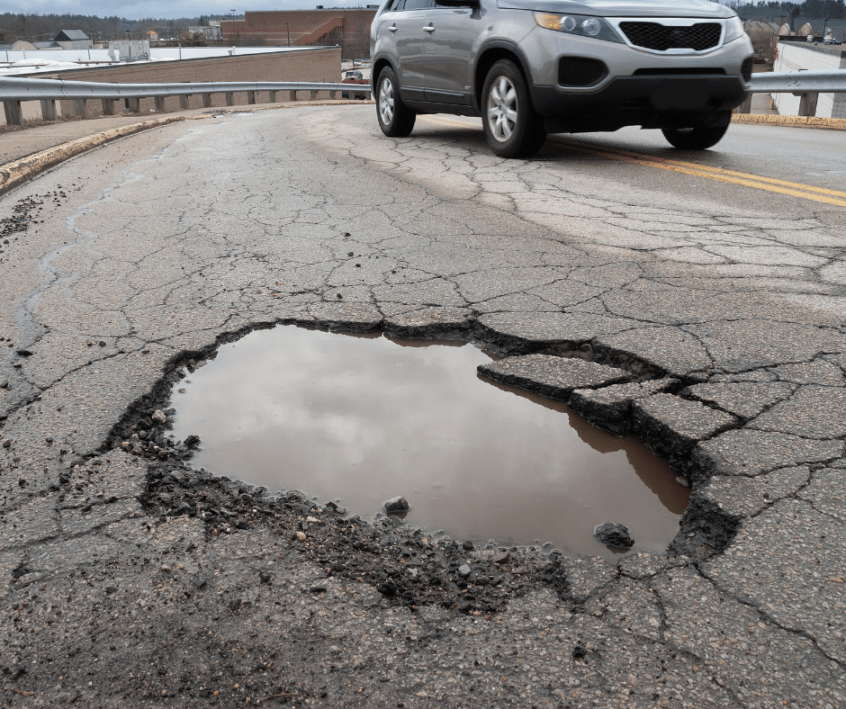It’s pothole season and we best be prepared to avoid them if we can! Canadians are no stranger to shifting temperatures and harsh climates. Our rapidly swinging conditions, freeze-and-thaw cycles, and excess of snow, rain, hail, and heat waves wreaks havoc on more than just our moods. That’s right, these fluctuating weather conditions inflict damage on our roadways too, oftentimes leading to potholes forming in the pavement. And unfortunately, driving over potholes can cause serious damage to our cars. Here’s what you need to know about avoiding these cracks of doom on the roads:
What is a Pothole?
A pothole is a hole found on the road, ranging in size, shape, and depth. They’re formed when water seeps in the substrate (or gravel) beneath the pavement surface through small cracks or holes in the road. Throughout the year, this liquid freezes and melts continuously, causing the ground to expand and contract, resulting in a pothole. While we’re more likely to see potholes in the winter and spring due to the snow and rainfall, potholes can appear any time of year. They’re not always easy to spot and can appear very suddenly, so drivers must always be on the lookout, even if driving down a familiar road.
How Do Potholes Damage Your Car?
Potholes can negatively affect a vehicle in more ways than one. In fact, our auto body shop in Vancouver often sees cars with multiple spots of damage due to potholes. Here are some of the areas to check on your car should you run over a pothole:
1. Tires
Since your tires make direct contact with the damaged piece of road, they could carry the brink of the damage. Look for sidewall bulges, tread separation, or deflating in your tires if you run over a pothole. Since these holes have hard, rough edges, your tires may compress on the areas which could break through the tough rubber. To reduce your odds of pothole inflicted tire damage, ensure that your wheels are always inflated to the recommended amount.
2. Rims
Not only can a pothole scratch the rims of your wheels, but they can also cause structural damage. Since potholes can cause your wheels to move in ways they’re not designed to, you can be left with bent, warped, and cracked rims, all of which will decrease the efficiency of your drive. To avoid cosmetic and structural damage to your wheels, avoid potholes in the road whenever possible.
3. Suspension
Driving over a pothole can be jarring for both your passengers and your vehicle. While your car’s suspension is designed to absorb impact, it can deteriorate when overused. Due to the sudden jolt your car experiences when hitting a pothole, several suspension issues can occur including misalignment, damaged shocks, and broken ball joints. Suspensions can be fixed, however, if left unattended to, your car will likely pull in one direction and suffer from uneven tire wear. If you notice strange vibrations, noises, or unusual veering when driving, take your car in for a checkup.
4. Exhaust
The exhaust pipes are found on the undercarriage of your vehicle, making them very susceptible to pothole damage. Some larger potholes can cause your car to bottom out, meaning the undercarriage will graze the road, leading to loss of power, severe damage, and engine leaks. Not to mention the extensive auto body damage. Exhaust damage can also be a serious health risk, as a leak can invite fumes into your car, polluting your air quality.
5. Auto Body
Sadly, your cars auto body is not immune to the plights of potholes. The smaller the car and the lower it sits on the ground, the higher the risk of damage is. Should you run over a pothole, any low-hanging bumpers and siding could suffer cosmetic damage upon impact. However, our auto body shop in Vancouver is equipped to repair cosmetic damage caused by potholes – or from other types of collision. Reach out today to speak with one of our highly trained auto body shop technicians!

